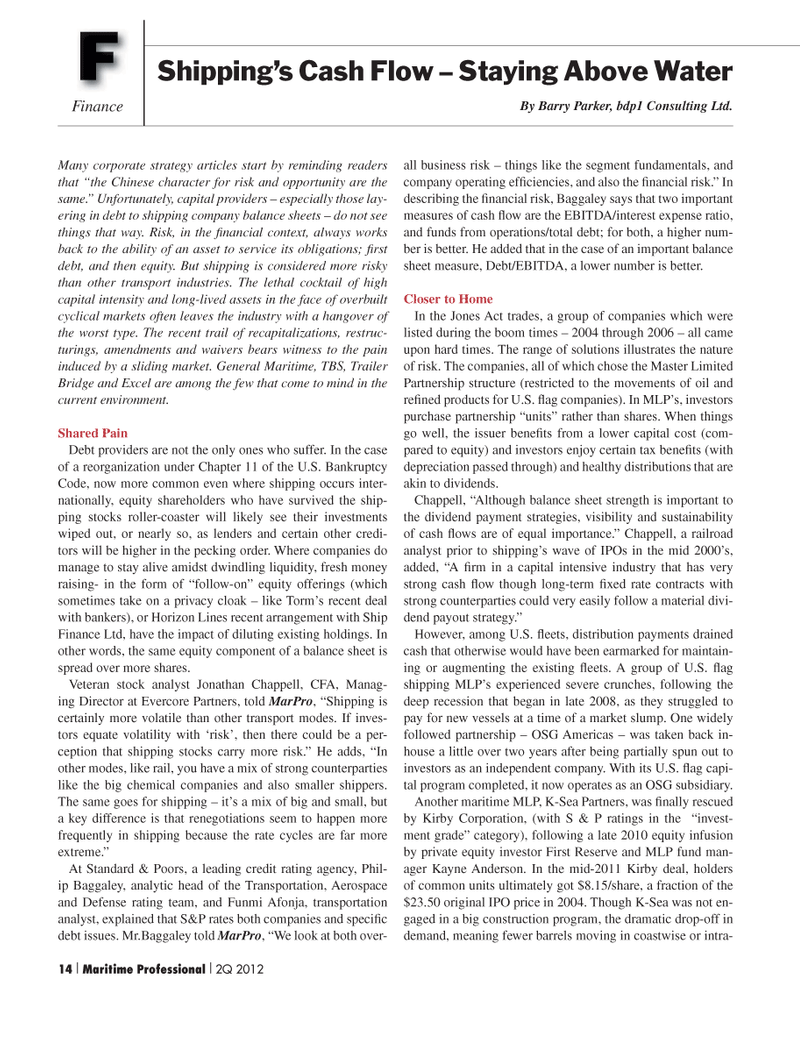
Page 14: of Maritime Logistics Professional Magazine (Q2 2012)
Maritime Risk
Read this page in Pdf, Flash or Html5 edition of Q2 2012 Maritime Logistics Professional Magazine
Many corporate strategy articles start by reminding readers that “the Chinese character for risk and opportunity are the same.” Unfortunately, capital providers – especially those lay- ering in debt to shipping company balance sheets – do not see things that way. Risk, in the fi nancial context, always works back to the ability of an asset to service its obligations; fi rst debt, and then equity. But shipping is considered more risky than other transport industries. The lethal cocktail of high capital intensity and long-lived assets in the face of overbuilt cyclical markets often leaves the industry with a hangover of the worst type. The recent trail of recapitalizations, restruc- turings, amendments and waivers bears witness to the pain induced by a sliding market. General Maritime, TBS, Trailer
Bridge and Excel are among the few that come to mind in the current environment.
Shared Pain
Debt providers are not the only ones who suffer. In the case of a reorganization under Chapter 11 of the U.S. Bankruptcy
Code, now more common even where shipping occurs inter- nationally, equity shareholders who have survived the ship- ping stocks roller-coaster will likely see their investments wiped out, or nearly so, as lenders and certain other credi- tors will be higher in the pecking order. Where companies do manage to stay alive amidst dwindling liquidity, fresh money raising- in the form of “follow-on” equity offerings (which sometimes take on a privacy cloak – like Torm’s recent deal with bankers), or Horizon Lines recent arrangement with Ship
Finance Ltd, have the impact of diluting existing holdings. In other words, the same equity component of a balance sheet is spread over more shares.
Veteran stock analyst Jonathan Chappell, CFA, Manag- ing Director at Evercore Partners, told MarPro, “Shipping is certainly more volatile than other transport modes. If inves- tors equate volatility with ‘risk’, then there could be a per- ception that shipping stocks carry more risk.” He adds, “In other modes, like rail, you have a mix of strong counterparties like the big chemical companies and also smaller shippers.
The same goes for shipping – it’s a mix of big and small, but a key difference is that renegotiations seem to happen more frequently in shipping because the rate cycles are far more extreme.”
At Standard & Poors, a leading credit rating agency, Phil- ip Baggaley, analytic head of the Transportation, Aerospace and Defense rating team, and Funmi Afonja, transportation analyst, explained that S&P rates both companies and specifi c debt issues. Mr.Baggaley told MarPro, “We look at both over- all business risk – things like the segment fundamentals, and company operating effi ciencies, and also the fi nancial risk.” In describing the fi nancial risk, Baggaley says that two important measures of cash fl ow are the EBITDA/interest expense ratio, and funds from operations/total debt; for both, a higher num- ber is better. He added that in the case of an important balance sheet measure, Debt/EBITDA, a lower number is better.
Closer to Home
In the Jones Act trades, a group of companies which were listed during the boom times – 2004 through 2006 – all came upon hard times. The range of solutions illustrates the nature of risk. The companies, all of which chose the Master Limited
Partnership structure (restricted to the movements of oil and refi ned products for U.S. fl ag companies). In MLP’s, investors purchase partnership “units” rather than shares. When things go well, the issuer benefi ts from a lower capital cost (com- pared to equity) and investors enjoy certain tax benefi ts (with depreciation passed through) and healthy distributions that are akin to dividends.
Chappell, “Although balance sheet strength is important to the dividend payment strategies, visibility and sustainability of cash fl ows are of equal importance.” Chappell, a railroad analyst prior to shipping’s wave of IPOs in the mid 2000’s, added, “A fi rm in a capital intensive industry that has very strong cash fl ow though long-term fi xed rate contracts with strong counterparties could very easily follow a material divi- dend payout strategy.”
However, among U.S. fl eets, distribution payments drained cash that otherwise would have been earmarked for maintain- ing or augmenting the existing fl eets. A group of U.S. fl ag shipping MLP’s experienced severe crunches, following the deep recession that began in late 2008, as they struggled to pay for new vessels at a time of a market slump. One widely followed partnership – OSG Americas – was taken back in- house a little over two years after being partially spun out to investors as an independent company. With its U.S. fl ag capi- tal program completed, it now operates as an OSG subsidiary.
Another maritime MLP, K-Sea Partners, was fi nally rescued by Kirby Corporation, (with S & P ratings in the “invest- ment grade” category), following a late 2010 equity infusion by private equity investor First Reserve and MLP fund man- ager Kayne Anderson. In the mid-2011 Kirby deal, holders of common units ultimately got $8.15/share, a fraction of the $23.50 original IPO price in 2004. Though K-Sea was not en- gaged in a big construction program, the dramatic drop-off in demand, meaning fewer barrels moving in coastwise or intra-
F
Finance
Shipping’s Cash Flow – Staying Above Water By Barry Parker, bdp1 Consulting Ltd. 14 I Maritime Professional I 2Q 2012
MP #2 1-17NEW STYLES.indd 14 5/4/2012 4:54:50 PM

 13
13

 15
15
